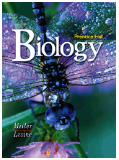BIOLOGY
by Miller & Levine
[complete Table of Contents]

|
Use the pull-down menu to jump to any of the Book's 40 Chapters: |
Additional Resources:
![]() Chapter 33
Chapter 33 ![]()
Comparing Chordates
In this chapter, students will read about broad trends in the evolution of the chordates and compare the adaptations of the major living groups of chordates.The links below lead to additional resources to help you with this chapter. These include Hot Links to Web sites related to the topics in this chapter, the Take It to the Net activities referred to in your textbook, a Self-Test you can use to test your knowledge of this chapter, and Teaching Links that instructors may find useful for their students.
| Hot Links | Chapter Self-Test |
| Take it to the Net | Teaching Links |
![]()
Section
33-1: Chordate Evolution
![]() The chordate family
tree has its roots in ancestors that vertebrates share with tunicates
and lancelets.
The chordate family
tree has its roots in ancestors that vertebrates share with tunicates
and lancelets.
![]() Over the course
of evolution, the appearance of new adaptations—such as jaws and
paired appendages—has launched adaptive radiation in chordate groups.
Over the course
of evolution, the appearance of new adaptations—such as jaws and
paired appendages—has launched adaptive radiation in chordate groups.
Section
33-2: Controlling Body Temperature
![]() The control of
body temperature is important for maintaining homeostasis in many vertebrates,
particularly in habitats where temperature varies widely with time of
day and with season.
The control of
body temperature is important for maintaining homeostasis in many vertebrates,
particularly in habitats where temperature varies widely with time of
day and with season.
![]() Most fishes, amphibians,
and reptiles are ectotherms—organisms that obtain heat from outside
their bodies. Birds and mammals are endotherms, which means they can generate
heat inside their bodies.
Most fishes, amphibians,
and reptiles are ectotherms—organisms that obtain heat from outside
their bodies. Birds and mammals are endotherms, which means they can generate
heat inside their bodies.
Section
33-3: Form and Function in Chordates
![]() The digestive
systems of vertebrates have organs that are well adapted for different
feeding habits.
The digestive
systems of vertebrates have organs that are well adapted for different
feeding habits.
![]() Aquatic chordates—such
as tunicates, fishes, and amphibian larvae—use gills for respiration.
Land vertebrates, including adult amphibians, reptiles, birds, and mammals,
use lungs.
Aquatic chordates—such
as tunicates, fishes, and amphibian larvae—use gills for respiration.
Land vertebrates, including adult amphibians, reptiles, birds, and mammals,
use lungs.
![]() During the course
of chordate evolution, the heart developed chambers and partitions that
help separate the blood traveling in the circulatory system.
During the course
of chordate evolution, the heart developed chambers and partitions that
help separate the blood traveling in the circulatory system.
![]() Nonvertebrate
chordates have a relatively simple nervous system with a mass of nerve
cells that form a brain. Vertebrates have a more complex brain with distinct
regions, each with a different function.
Nonvertebrate
chordates have a relatively simple nervous system with a mass of nerve
cells that form a brain. Vertebrates have a more complex brain with distinct
regions, each with a different function.
![]() Muscular and skeletal
systems support a vertebrate's body and make it possible to control movement.
Muscular and skeletal
systems support a vertebrate's body and make it possible to control movement.
Click Here for Science News articles on Chordates and Vertebrates